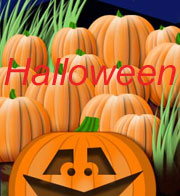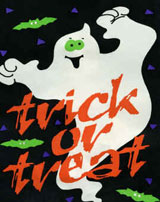|
 On October 31st, dozens of children dressed in
costumes(節(jié)日服裝)knock on their neighbors' doors and yell "Trick or Treat" when the door opens. Pirates and princesses, ghosts and popular heroes of the day all hold bags open to catch the candy or other goodies that the neighbors drop in. As they give each child a treat the neighbors exclaim over the costumes and try to guess who is under the masks. On October 31st, dozens of children dressed in
costumes(節(jié)日服裝)knock on their neighbors' doors and yell "Trick or Treat" when the door opens. Pirates and princesses, ghosts and popular heroes of the day all hold bags open to catch the candy or other goodies that the neighbors drop in. As they give each child a treat the neighbors exclaim over the costumes and try to guess who is under the masks.
Since the 800's November 1st is a religious holiday known as
All Saints' Day(萬(wàn)圣節(jié)). The Mass that was said on this day was called Allhallowmas. The evening before became known as All Hakkiw e'en, or Halloween. Like some other American celebrations, its origins lie in both pre-Christian and Christian customs.
October 31 st was the eve of the
Celtic(凱爾特人的)new year. The Celts were the ancestors of the present-day Irish, Welsh and Scottish people. On this day ghosts walked and mingled with the living, or so the Celts thought. The townspeople baked food all that day and when night fell they dressed up and tried to resemble the souls of the dead. Hoping that the ghosts would leave peacefully before midnight of the new year.
Much later, when Christianity spread throughout Ireland and October 31 was no longer the last day of the year, Halloween became a celebration mostly for children. "Ghosts" went from door to door asking for treats, or else a trick would be played on the owners of the house. When millions of Irish people immigrated to the United States in the 1840s the tradition came with them.
Today' school dances and neighborhood parties called "block parties" are popular among young and old alike. More and more adults celebrate Halloween. They dress up like historical or political figures and go to
masquerade parties(化妝舞會(huì)). In larger cities, costumed children and their parents gather at shopping malls early in the evening. Stores and businesses give parties with games and treats for the children.Teenagers enjoy costume dances at their schools and the more outrageous the costume the better!
Certain
pranks(惡作劇)such as soaping car windows and tipping over garbage cans are expected. But partying and pranks are not the only things that Halloweeners enjoy doing. Some collect money to buy food and medicine for needy children around the world.
 Symbols of Halloween Symbols of Halloween
 Halloween originated as a celebration connected with evil spirits. Witches flying on broomsticks with black cats, ghosts,
goblins(小精靈)and skeletons have all evolved as symbols of Halloween. They are popular trick-or-treat costumes and decorations for greeting cards and windows. Black is one of the traditional Halloween colors, probably because Halloween festivals and traditions took place at night. In the weeks before October 31, Americans decorate windows of houses and schools with
silhouettes(輪廓)of witches and black cats. Halloween originated as a celebration connected with evil spirits. Witches flying on broomsticks with black cats, ghosts,
goblins(小精靈)and skeletons have all evolved as symbols of Halloween. They are popular trick-or-treat costumes and decorations for greeting cards and windows. Black is one of the traditional Halloween colors, probably because Halloween festivals and traditions took place at night. In the weeks before October 31, Americans decorate windows of houses and schools with
silhouettes(輪廓)of witches and black cats.
Pumpkins are also a symbol of Halloween. The pumpkin is an orange-colored squash, and orange has become the other traditional Halloween color. Carving pumpkins into jack- o'lanterns is a Halloween custom also dating back to Ireland. A legend grew up about a man named Jack who was so
stingy(吝嗇的)that he was not allowed into heaven when he died, because he was a
miser(吝嗇鬼). He couldn't enter hell either because he had played jokes on the devil. As a result, Jack had to walk the earth with his lantern until
Judgement Day(審判日). The Irish people carved scary faces out of
turnips(蕪菁根),
beets(甜菜根)or potatoes representing "Jack of the Lantern," or Jack-o'lantern. When the Irish brought their customs to the United States, they carved faces on pumpkins because in the autumn they were more plentiful than turnips. Today jack-o'-lanterns in the windows of a house on Halloween night let costumed children know that there are goodies(糖果)waiting if they knock and say "Trick or Treat!"
 Halloween Treats Halloween Treats
Dried Pumpkin Seeds
After carving your pumpkin, separate the pulp from the seeds.
Rinse(沖洗)the seeds and spread them out to dry. The next day, add enough melted butter or
margarine(人造黃油)to coat each seed. Spread the seeds onto a
cookie sheet(甜酥餅干)and bake for 20 minutes in a 300 degree oven for 20 minutes or until they are slightly brown.
Caramel Apples
Take the paper wrapping off about 100
caramels(飴糖)and put them in a
saucepan(燉鍋). Put the saucepan over a pan of boiling water. Boil the water until the caramels melt. Put a wooden stick into the top of each apple, dip the apple into the caramel. Let them cool on wax paper and enjoy!
Scary Stories
No Halloween party is complete without at least one scary story. Usually one person talks in a low
voice while everyone else crowds together on the floor or around a fire. The following is a retelling of a tale told in Britain and in North Carolina and Virginia.
"What Do You Come For?"
There was an old woman who lived all by herself, and she was very lonely. Sitting in the kitchen one night, she said, "Oh, I wish I had some company."
No sooner had she spoken than down the chimney tumbled two feet from which the flesh had rotted. The old woman's eyes bulged with terror.
Then two legs dropped to the hearth and attached themselves to the feet.
Then a body tumbled down, then two arms, and a man's head.
As the old woman watched, the parts came together into a great, tall man. The man danced around and around the room. Faster and faster he went. Then he stopped, and he looked into her eyes.
"What do you come for? she asked in a small voice that shivered and shook.
"What do I come for?" he said. "I come for YOU!"
The narrator shouts and jumps at the person near him!
|